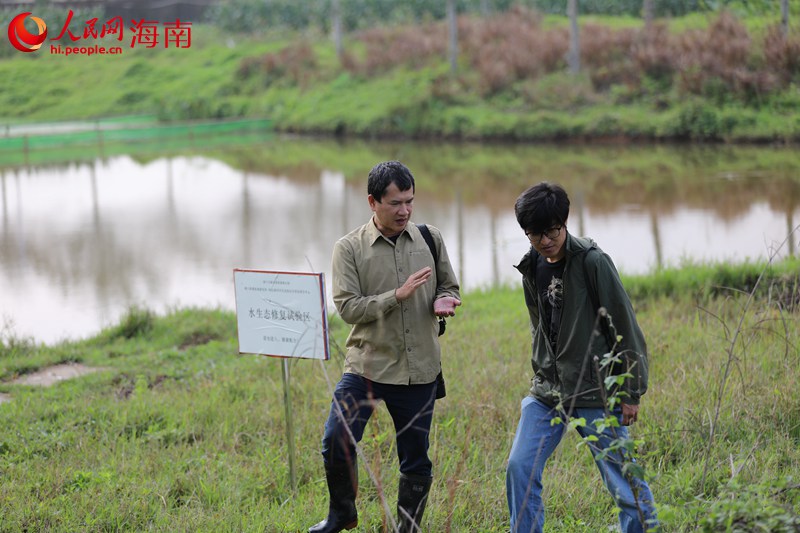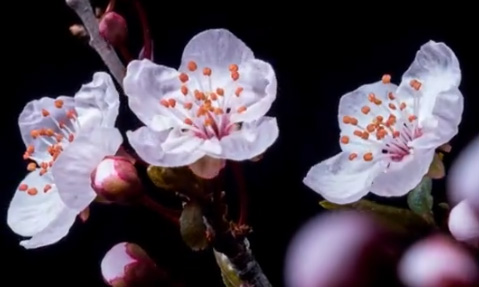Botany teacher devotes himself to protection of wetland home for waterfowl species in Hainan
Lu Gang, head of a wetland research institute in Haikou, south China’s Hainan Province, has remained dedicated to protecting birds for 15 years. He began photographing birds in 2007 as a way to raise more public awareness towards the protection of bird populations.

Photo shows Lu Gang (L) and his colleague engaged in a field survey. (People’s Daily Online/Meng Fansheng)
Previously a botany teacher at a college, Lu often participated in field surveys organized by the local forestry bureau because of his extensive knowledge conducting field research and his excellent photography skills. During the process, Lu became familiar with and more interested in Hainan’s efforts to protect wildlife species. He then quit his job as a college teacher and joined in the efforts.
Lu has now become an expert in species conservation. “We will observe the changes in species at each monitoring site and accumulate data, which can help guide the better management of the environment and protect the environment,” Lu said.
“I have been to the most beautiful places in Hainan because of my work schedule,” Lu noted, adding that he felt very lucky to turn his hobby into a career.
Lu recalled how excited he was when he used his camera to capture images of black-faced spoonbills, a species of bird under first-class state protection, at the Yinggehai salt farm in Hainan several years ago. “It’s the first time that the bird species had been discovered at the salt farm,” the man said.
An increasing number of black-faced spoonbills now overwinter in Hainan. Lu introduced that among the six habitats for the bird species in the province, the Yinggehai salt farm is the only one that is not listed as a protected area. But it is also the only place where the bird’s population decreased significantly from the previous year.

Lu Gang takes a moment to remove some weeds. (People’s Daily Online/Meng Fansheng)
Lu suggested establishing a nature park at the salt farm to better protect waterfowl species, including black-faced spoonbills.
Lu has also devoted himself to stimulating the broader public to participate in nature observation and research activities via the medium offered through the camera lens. Photographs help enhance the level of publicity for the protection of bird species, according to Lu.
In recent years, endangered bird species such as the black-faced spoonbill and the spoon-billed sandpiper have been frequently spotted in Hainan, and some bird species that had once disappeared in the province, including cotton pygmy geese and black-billed gulls, have returned in larger numbers to the area.
This indicates that Hainan’s measures to restore the ecological environment have proved effective, while more and more people have begun to actively engage in bird watching, Lu said.
“There were few bird watchers some 10 or more years ago. But now a WeChat group I joined includes hundreds of bird watchers,” Lu added, explaining that people’s awareness towards environmental protection has been improved.
“In addition to research institutes and public institutions, more social organizations have gotten engaged in ecological conservation efforts, and young people have joined in the efforts,” Lu said.

Photo shows a pilot zone for the restoration of a water ecosystem. (People’s Daily Online/Meng Fansheng)

Photo shows the Wuyuanhe National Wetland Park in Haikou, capital of south China’s Hainan Province. (People’s Daily Online/Meng Fansheng)
Photos
Related Stories
- Yazhou Bay Seed Laboratory in Sanya, S China's Hainan
- Hainan's tropical rainforest park a highlight of national ecological progress
- Fishermen of south China's Hainan greet late spring season with bountiful catch
- Newborn rare gibbon spotted in Hainan national park
- Hainan's Maona Village promotes rural tourism to increase locals' incomes, expedite rural revitalization
- Xi stresses boosting national park development in Hainan
- Xi inspects Wuzhishan in Hainan
- Breathtaking Hainan Tropical Rainforest National Park in a snapshot
- Haikou duty-free shopping complex under construction
- Villager devotes himself to protecting wetland for 22 years in NW China’s Qinghai
Copyright © 2022 People's Daily Online. All Rights Reserved.










